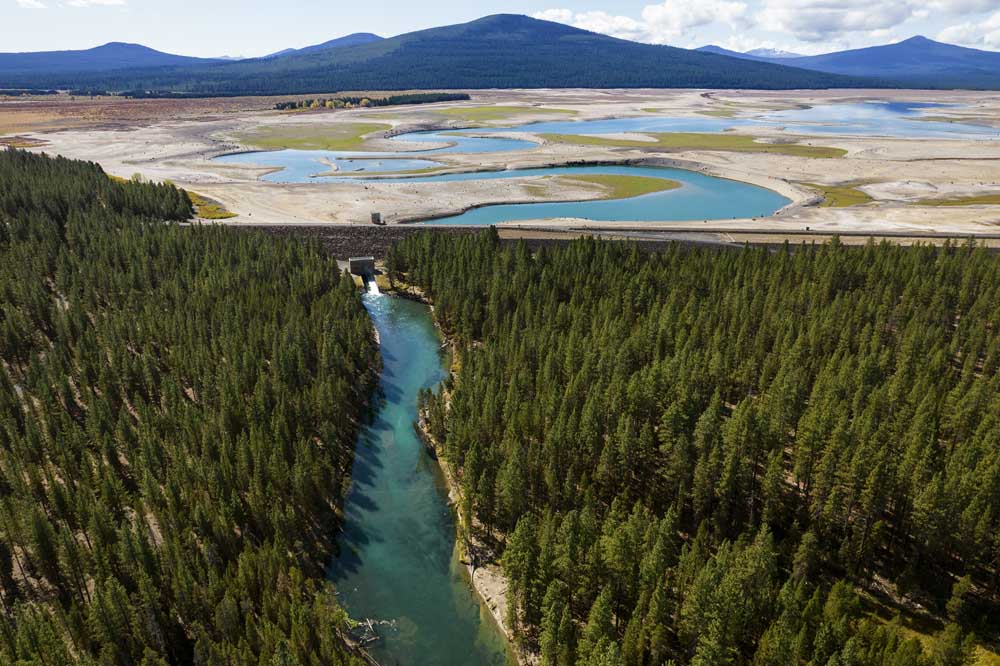Central Oregon water bank off to a slow start but state funds could help
Published 3:45 pm Friday, March 24, 2023

- Water flows through the dam at Wickiup Reservoir on Oct. 6, 2021. Ongoing drought left the reservoir empty before irrigation season concluded.
A water bank intended to help Jefferson County farmers survive a historic drought is off to a slow start but could get significant funding from a newly proposed drought bill making its way through the Oregon Legislature.
The $250 million Bipartisan Drought Relief and Water Security package contains $2 million of financial support for a water bank and other drought resiliency measures. If approved, the funds would be issued to the Deschutes River Conservancy, a Bend-based non-profit organization that oversees the Deschutes Water Bank in partnership with Central Oregon and North Unit irrigation districts.
A portion of the $2 million is slated to go toward implementing the water bank. Other funds will be directed to on-farm efficiency, canal piping, and habitat restoration in the upper Deschutes River basin.
The water bank program, which started last year, allows Central Oregon Irrigation District patrons to temporarily “sell” their water to North Unit Irrigation District, a junior water rights holder.
Central Oregon Irrigation District patrons that participate in the water bank are compensated $100 per acre by North Unit. North Unit also pays $25 per acre to Central Oregon Irrigation District for administering the program, making the total cost to North Unit $125 per acre. Funding is provided by the Oregon Watershed Enhancement Board.
There are also environmental benefits. North Unit is required to release 25% of the water it gets through the project next winter into the river, helping to increase river flows in winter to benefit wildlife.
The drought package, a bipartisan effort led by Reps. Ken Helm, D-Beaverton, and Mark Owens, R-Crane, is designed to help make Oregon more resilient in the face of drought. It includes assistance to domestic well users, tribes, government agencies, and drinking water distributors to improve water use efficiency. The package was presented this month to the House Committee on Agriculture, Land Use, Natural Resources, and Water.
Irrigation districts with junior water rights are typically the first to run out of water due to their limited allocations. North Unit has been rationing its water supply during the recent drought years, forcing district patrons to cut their available growing acres.
In its inaugural effort last year, the water bank saved 90 acres of Central Oregon Irrigation District land from being watered, with the water savings transferred to North Unit. This year, that number dropped to 76 acres, which will equal 320 acre-feet, or 104 million gallons of water.
Seventy-six acres is a fraction of the 45,000 total acres in the Central Oregon Irrigation District.
This year’s water will come off land owned by the city of Redmond near the city’s airport. Other applicants were not approved.
Mike Britton, executive director for North Unit Irrigation District, said he was hoping for more than 76 acres this year but admits it may take time for water users to get on board.
“I think it’s just going to take some time to get folks comfortable with the concept and the process,” he said.
Oregon’s water law may also be preventing more from signing up due to a rule that requires irrigation district patrons to prove “beneficial use” once every five years. In order to prove beneficial use and protect water right, a patron must water the property or lease it instream.
An instream lease allows water rights to be temporarily leased back to the Deschutes River in exchange for a designation of beneficial use. Leaving the water in the river improves Deschutes River water quality, supporting habitat for fish and wildlife. Participating in the water bank program does not count toward beneficial use.
“COID does not allow patrons who have not used water in the last several years to participate in the bank, instead urging them to use it on their ground or lease it instream,” said Kate Fitzpatrick, executive director of the Deschutes River Conservancy. “A bill has been introduced into the legislature that could eliminate this barrier as well.”
Fitzpatrick said operational challenges at Central Oregon Irrigation District also account for the low participation.
Another hurdle is Central Oregon Irrigation District’s antiquated canal system, which was built in porous volcanic rock which causes high seepage rates. This system makes physically transferring water from one area to another more difficult. Greater investment in Central Oregon Irrigation District’s management and delivery system will help eliminate barriers, said Fitzpatrick.
“If laterals are piped, those issues go away,” said Fitzpatrick. “With increased measurement and the ability to track water, it will become easier for COID to manage moving water from place to place or not delivering water to certain patrons.”
Twenty Central Oregon Irrigation District patrons applied to join the water bank this year but were unable to participate due to not qualifying for the program, mainly related to infrastructure obstacles or beneficial use requirements.
Fitzpatrick said when infrastructure improvements allow more people to participate she expects that water from 5% of Central Oregon Irrigation District acres can be banked for use by North Unit.
The Deschutes River Conservancy is currently investing in making those improvements by helping to pipe district and private laterals and conducting other on-farm improvements.
Fitzpatrick said additional funds from the state’s drought package will provide additional support.
“The drought package includes $2 million for a combination of water banking, measurement, and off-farm efficiency work in COID and habitat restoration,” said Fitzpatrick. “Moving all of these pieces forward together will open up opportunities to scale the water banking program.”






